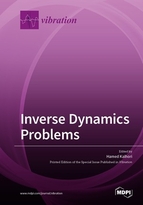Inverse Dynamics Problems
A special issue of Vibration (ISSN 2571-631X).
Deadline for manuscript submissions: closed (30 November 2020) | Viewed by 40560
Special Issue Editor
2. Department of Mechanical Engineering, Faculty of Engineering, Bu-Ali Sina University, Hamedan 65167-38695, Iran
Interests: structural health monitoring; inverse problems; sensors and signal processing
Special Issues, Collections and Topics in MDPI journals
Special Issue Information
Estimation of system inputs or internal reactions by direct measurements for many real systems is complicated or impossible, either because the system input is inaccessible or unknown or simply because the nature of input is unknown and therefore cannot be instrumented. An inverse problem strategy is, therefore, a promising solution for such scenarios.
An inverse problem is about identifying the cause of an effect utilizing a set of observations and measurement of the system response. As opposed to a forward problem yielding the system response, an inverse problem manipulates the effects considering the system natural behavior to predict the inputs to the system.
Inverse dynamics, in particular, focusing on structural dynamics and/or inverse rigid body dynamics, calculates the applied forces or internal forces and moments from measurements of structural vibrations and/or rigid body motions. These types of problems are normally challenging as there are uncertainties that are usually amplified through the inverse process and therefore need to be properly addressed.
The objective of this Special Issue is to create a forum of discussion, for research scientists and engineers working in the area of inverse structural dynamics and inverse rigid body kinematics. We invite researchers to submit both original research and review articles.
The Special Issue will cover a range of topics including but not limited to the following:
- Impact force identification;
- Time-varying load identification;
- Moving load identification;
- Bridge-weight-in-motion systems;
- Vehicle–bridge interaction dynamics;
- Regularization in force identification;
- Uncertainties in inverse dynamics problems;
- Time-varying system identification;
- Sound source reconstruction;
- Experimental modal analysis;
- Operational modal analysis;
- Inverse dynamics with application in structural health monitoring;
- Human body and animal body inverse dynamics problems.
Dr. Hamed Kalhori
Guest Editor
Manuscript Submission Information
Manuscripts should be submitted online at www.mdpi.com by registering and logging in to this website. Once you are registered, click here to go to the submission form. Manuscripts can be submitted until the deadline. All submissions that pass pre-check are peer-reviewed. Accepted papers will be published continuously in the journal (as soon as accepted) and will be listed together on the special issue website. Research articles, review articles as well as short communications are invited. For planned papers, a title and short abstract (about 100 words) can be sent to the Editorial Office for announcement on this website.
Submitted manuscripts should not have been published previously, nor be under consideration for publication elsewhere (except conference proceedings papers). All manuscripts are thoroughly refereed through a single-blind peer-review process. A guide for authors and other relevant information for submission of manuscripts is available on the Instructions for Authors page. Vibration is an international peer-reviewed open access quarterly journal published by MDPI.
Please visit the Instructions for Authors page before submitting a manuscript. The Article Processing Charge (APC) for publication in this open access journal is 1600 CHF (Swiss Francs). Submitted papers should be well formatted and use good English. Authors may use MDPI's English editing service prior to publication or during author revisions.
Keywords
- inverse dynamics
- force identification
- force reconstruction
- bridge-weigh-in-motion
- modal analysis
- structural health monitoring
- human body dynamics
- regularization
Related Special Issue
- Inverse Dynamics Problems, Volume II in Vibration (3 articles)






